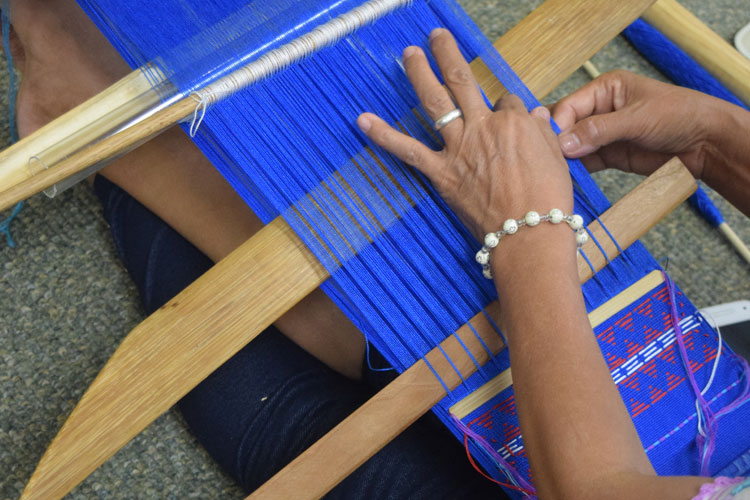
Symbols
The Karen national flag consists of three main colors: red, blue, and white. On the top left corner is the traditional Karen frog drum to symbolize unity in traditional Karen culture. It is called the frog drum because it is covered with frog skin. The three colors denote a certain meaning; red is for bravery, white for purity/sincerity, and blue for honesty. The nine rays of light streaming from the rising sun indicate the nine regions from which Karen people trace their origins. In the different regions of Burma where the Karen live, and even abroad, Christian and Buddhist Karen used the Karen national flag for Wrist Tying ceremonies, public or cultural meetings and the Karen New Year.
Dance
Don Dance
The don dance is a series of dances performed by groups of dancers and accompanied by traditional Karen instruments. Don means to be in agreement. The person who leads the dance is called the don koh. Don dancing originated with the Pwo Karen, who developed it as a way to reinforce community values. However, the don dance has changed in significant ways since then. Under military dictatorship it was used to glorify Burmese socialism and then for the musical expression of the village or regional pride. Now, the don dance is known as a musical expression for national pride—or Karen nationalism. It is performed at many celebrations.
Karen Bamboo Dance
The popular Karen bamboo dance is performed at many celebrations and involves quick dance steps to avoid getting stuck in the moving bamboo poles. It involves a high level of practice, skills and timing. One wrong move and a dancer’s foot could be struck by the bamboo poles. The Karen bamboo dance is played at ceremonies: Christmas, Karen New Year, Church functions, and Pagoda festivals. The Karen bamboo dance is also quite well known and popular among other races in Myanmar.
Clothing
Traditional clothing incorporates rich hues of red or blue woven into shirts and dresses. Weaving is an important folk art in Karen culture. Back in refugee camps, women often weaved in order to make money to buy food and school supplies for their children. They made woven scarves, shirts and bags. Weaving is an art the Karen value and teach to their children and the generations after. Now in Minnesota, Karen women have been given an opportunity to continue this art through KOM’s Weaving Circle.
Men display intricate tattoos, believed to signify character and protect against harm or evil. The Karen women wear brass neck rings, usually recognized from the Padaung tribes. The neck rings distort the growth of their collarbones and elongate their necks, by pressing down on the vertebrae and collar bones. A woman may have 20 or more rings worn around her neck. The rings around the necks, arms, and knees are sometimes explained as a traditional protection against tiger bites.
The type of traditional clothing worn by men and women varies on marital status:
- Karen men wear a longyi and a sleeveless shirt (usually red) or a white say plo (men’s dress).
- Unmarried Karen women wear a long white dress.
- Married Karen women wear a sarong and sleeveless shirt (usually black).
Information shared from:
http://www.culturecareconnection.org/matters/diversity/karen.html
https://ethnomed.org/culture/karen/karen-culturalprofile
http://www.burmalink.org/background/burma/ethnicgroups/karen/
http://www.drumpublications.org/wrist.php


 (651)788-7593
(651)788-7593


